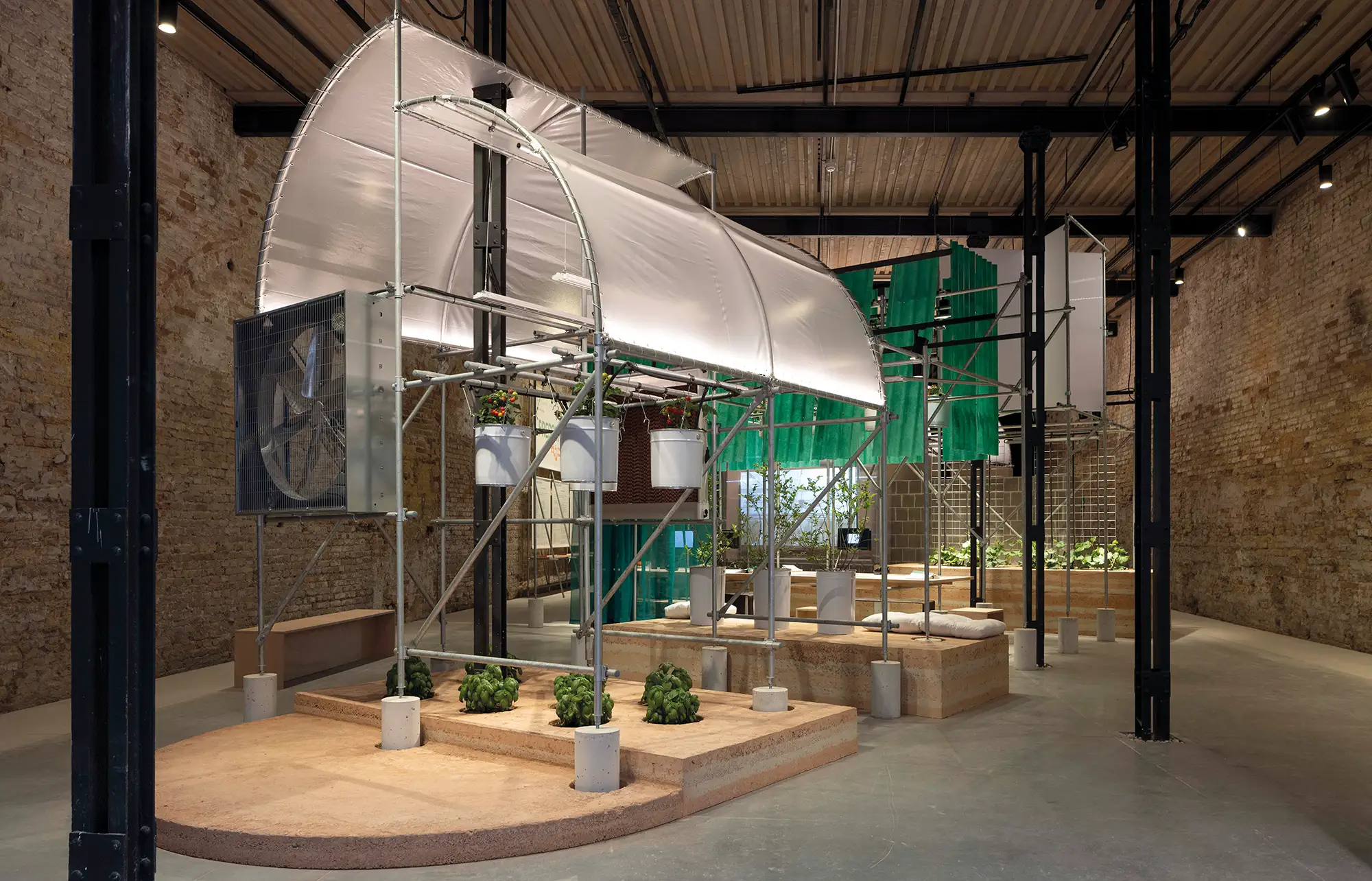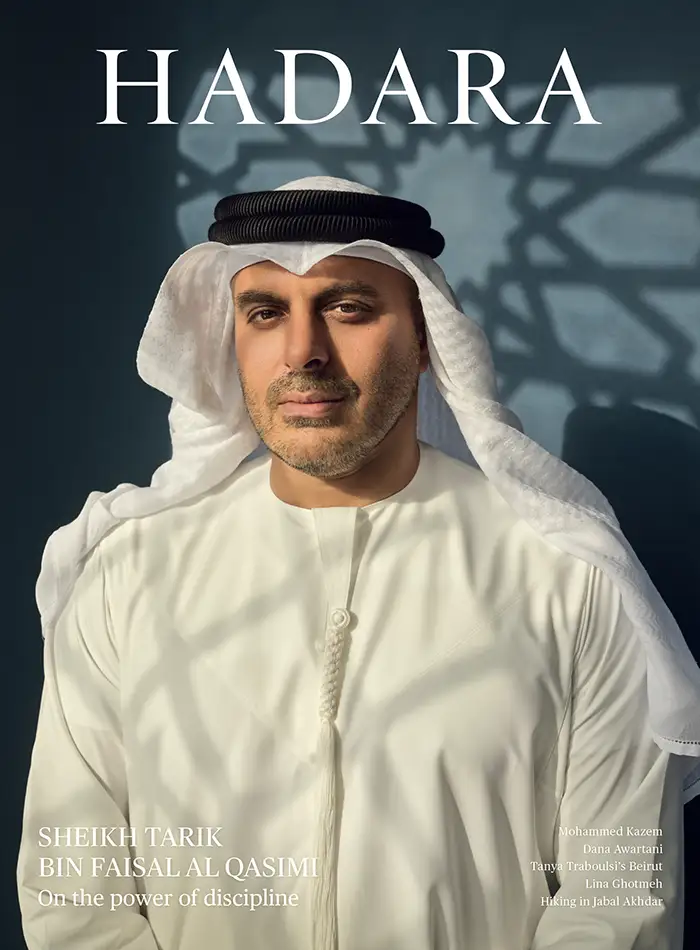Pressure cooker
Azza Aboualam explores how architecture can respond to the food-security challenge.
By Charles Shafaieh
For Azza Aboualam, a tinge of irritation often accompanies grocery shopping. A Sharjah native, the architect and assistant professor at Dubai’s Zayed University frequently faces questions from her mother about the origins of fruit and vegetables. Whether onions or kiwis, strawberries or mangos, the answers invariably include South Africa, India, the US, and myriad distant countries. Recently, however, a package of blueberries occasioned a surprising response: the UAE. Investigating how these and other crops could thrive in this arid country was the question that spurred her to design Pressure Cooker, on view in the UAE pavilion at the International Architecture Exhibition in Venice until November 23.
The perception that little grows in the Emirati desert due to limited fresh water, saline soil, and extreme temperatures is widespread. It is also false. While today only about 1% of the nation’s land is used for agriculture, from which just 10% of its food is produced, the UAE has a remarkable agricultural history. Wells in Dibba and Kalba have supported figs and melons. In Khorfakkan, they have allowed lemon and orange trees to flourish. Ras Al Khaimah’s own water sources have given rise to barley and sweet potatoes. Bread is made from wheat fields in Mleiha. And as recently as the 1980s, during a boom in farm building which at its height led to the production of 500,000 tons of produce for domestic use, Fujairah grew bananas, pomegranates, courgettes, aubergines, and many other crops.
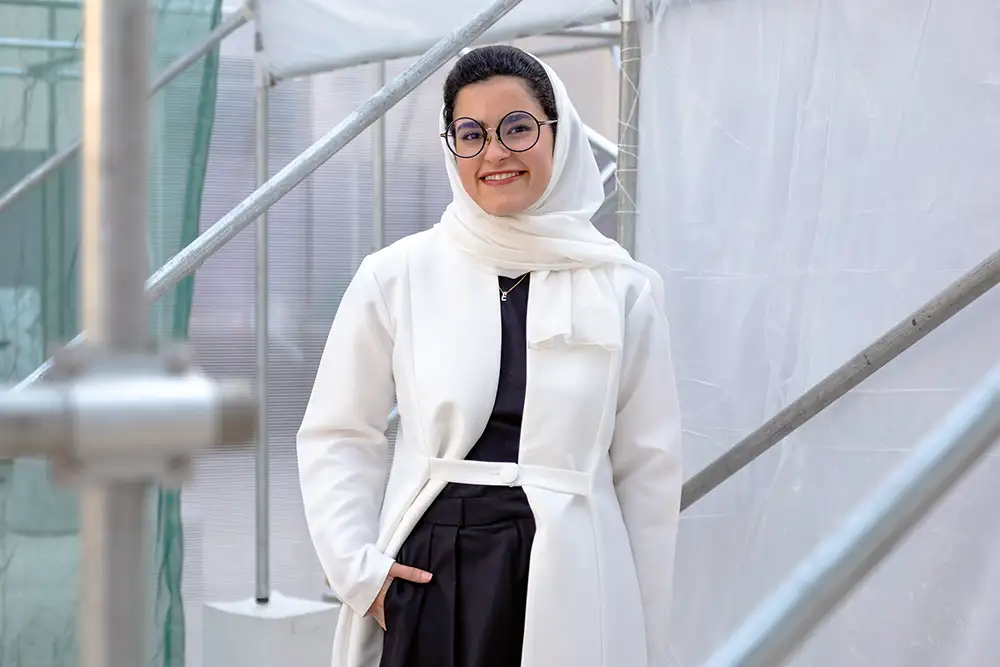
Hero image: Pressure Cooker, on view in Venice until November 23, invites visitors to consider how food, architecture, and new thinking about space can intersect. Azza Aboualam, above, the exhibition’s curator, is an architect, assistant professor at Zayed University, and co-founder of Holesum Studio. Pressure Cooker: Ismail Noor/Seeing Things. Aboualam: Nino Consorte/Seeing Things. Both images courtesy of National Pavilion UAE—La Biennale Di Venezia.
Greenhouses are among the tools that helped facilitate this cornucopia. First developed 2,000 years ago for the Roman emperor Tiberius, whose physicians prescribed him a daily dose of a cucumber-like melon that was ill suited to European winters, they have typically been employed to create an enclosed space warmer than the temperature outside. But in the UAE, since their introduction in 1967, they are used as a means of protection from the region’s high heat and humidity, allowing the growing season to double or even triple in duration. They also allow the cultivation of produce, such as blueberries, that would otherwise not survive there.
Arid landscapes will increase rapidly due to climate change, compelling us to look to those places that have centuries of agricultural experience under these conditions. With Pressure Cooker, Aboualam positions the UAE as a case study to ask how architecture can be mobilised to deliver greater food security.
In the Sale d’Ari in Venice, three working greenhouses are tightly situated in the cool, brick-lined space in a manner that echoes the findings of Aboualam and her team’s field research. They visited 150 sites across the UAE and discovered greenhouses in similarly unexpected places and configurations. “They were often hidden behind fences or walls and were sitting uncomfortably in their locations, making it clear they were built after the house or the neighbourhood expanded,” says Aboualam. “There was a discomfort or weird schism between the urge to grow, say, tomatoes and to make the plot of land work. We wanted to highlight this tension in the exhibition.”
“Pressure Cooker reimagines greenhouse design through a modular kit of parts, deconstructing its architecture into basic elements: roof, wall, floor, and cooling materials,”
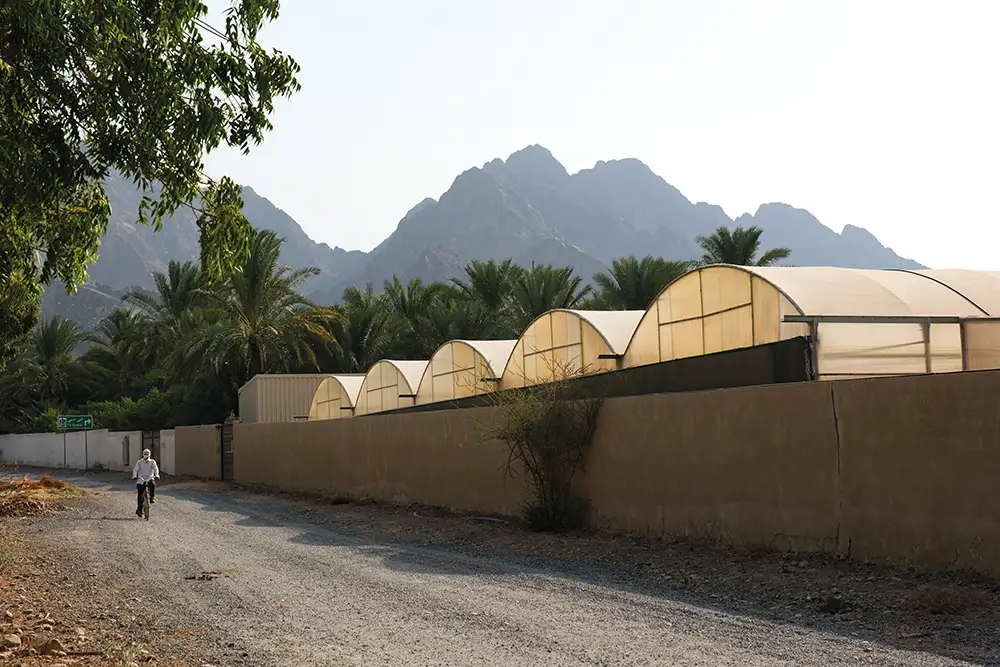
As part of their field research, Aboualam and her team visited 150 sites across the UAE. Photo: Ola Allouz.
What surprises visitors most however, Aboualam says, is the scent of basil that greets them as they enter the room. As they move deeper inside the space, they encounter tomatoes, cucumbers, and blueberries too. These agricultural successes are in part the result of a digital tool developed by Holesum Studio—an architectural design and research firm co-founded by Aboualam—that determines the ideal greenhouse design for a particular crop in relation to an area’s external factors such as temperature, amount of sunlight and shade, and humidity.
“Pressure Cooker reimagines greenhouse design through a modular kit of parts, deconstructing its architecture into basic elements: roof, wall, floor, and cooling materials,” Aboualam says. As a result, a seemingly infinite number of design permutations is possible.
For example, the barjeel roof model on display, inspired by the region’s traditional architecture, can eliminate the use of fans and electricity for ventilation by channelling cooler air in and purging warm air. The same model incorporates green fibreglass “walls”, which assist in retaining cooler air. The colour is intentional: research indicates that green fibreglass as well as green shade nets perform best in reducing the effects of intense sun exposure. Other types of cooling, including concrete blocks that help minimise temperature fluctuations, rammed-earth platforms that incorporate geothermal cooling, and evaporative cooling pads, are also on display. The latter method is less sustainable, as it uses freshwater that evaporates with the help of a fan to lower temperatures. Aboualam’s design instead uses seawater. Together, these prototypes suggest ways in which design can increase the resilience of food systems.
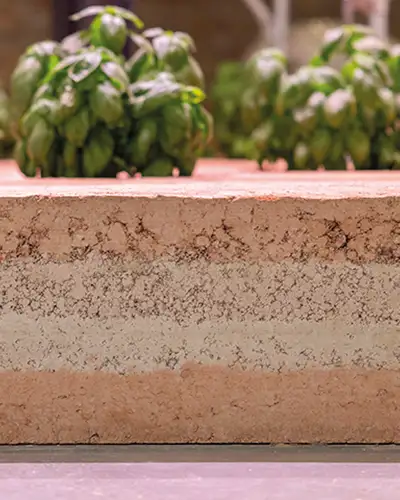
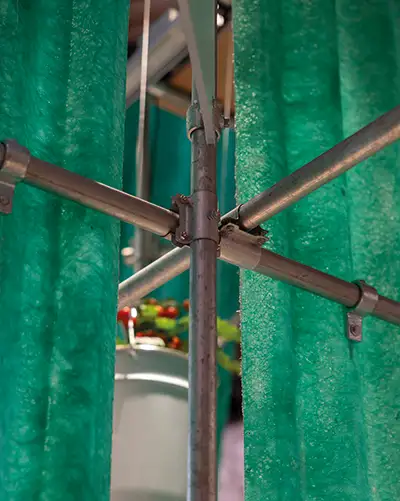
Above left, rammed-earth platforms mitigate heat from the ground. Above right, green fibreglass screens shield plants from sun exposure. Opposite, greenhouses enable farmers to extend growing seasons and increase yields. Photos: Ismail Noor/Seeing Things, courtesy of National Pavilion UAE—La Biennale Di Venezia.
While the digital programme helps imagine an ideal fusion of architecture and agriculture, it does not by itself act as a solution. Farmers in the UAE are familiar with the challenges related to greenhouses and can be sceptical about their installation, especially untested models. “After a greenhouse is put together, there is a lot of maintenance that goes into them,” says Aboualam. “These farmers have cautioned me against the idea that you just build it and grow your food.” This is in part why her team endeavoured to make their kit of parts as easy as possible to install in a space as small as a backyard, with the simplest model’s instructions emulating IKEA furniture. She also envisions a handout that would accompany the kit that answers key concerns such as what to do if mould is found and the optimal months for planting particular crops.
The applications of this research extend well beyond the UAE, addressing Biennale curator Carlo Ratti’s hope that “if every country brings one success to the table, together we can assemble a global kit for adapting to the future.”
“The structures’ materiality could be changed to allow them to be built in non-arid climates,” explains Aboualam. “They could be based on context. In areas like England, where the sun is not always present, the plastic could be UV amplifying instead of UV blocking.” The hope is that the digital tool, which at present uses data provided by UAE airports, will eventually become user-friendly for lay people and could be used anywhere.
Greenhouses that fit in rural and urban environments alike also help people become less alienated from agriculture, which Aboualam sees as a trend internationally. Whether in California, Cuba, or Oman, community gardens are increasing in popularity, especially within cities, serving as both educational opportunities and sites for social interaction. Emirati farmers know how vital this work is, both for sustenance and for the soul. “I spoke with amateur farmers who love the aspect of growing their own food and feeding their families,” she says. “One woman in Al Ain barely makes any money from her farm, but she grows her cucumbers because her husband used to do it, and she wants to carry on that legacy.”
Even growing plants in the pavilion has brought Aboualam joy, confirming how empowering these modular greenhouses can be. “The cucumbers surpassed my expectations,” she says, smiling broadly. “I’m very proud of them.”
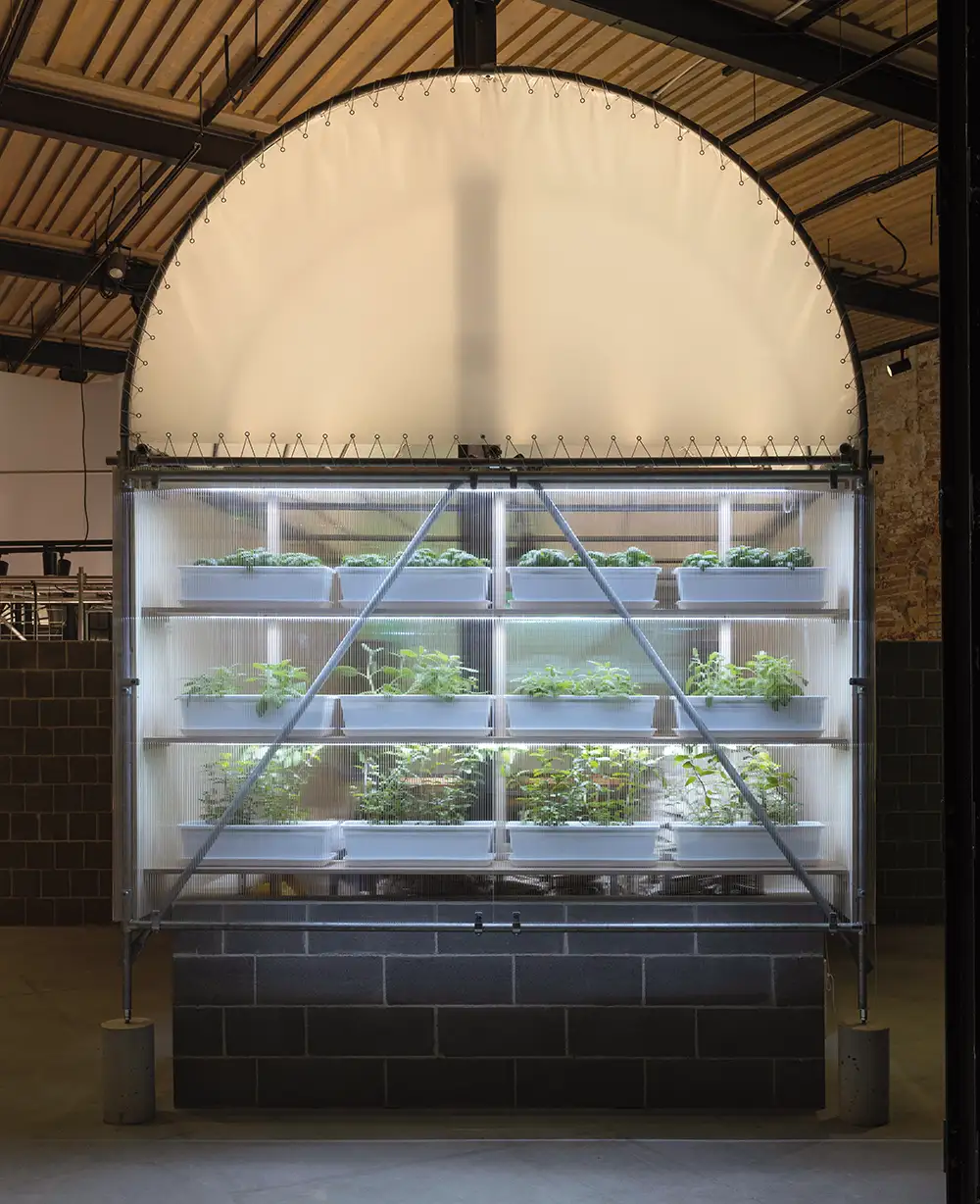
Greenhouses enable farmers to extend growing seasons and increase yields. Ph: Ismail Noor/Seeing Things.

